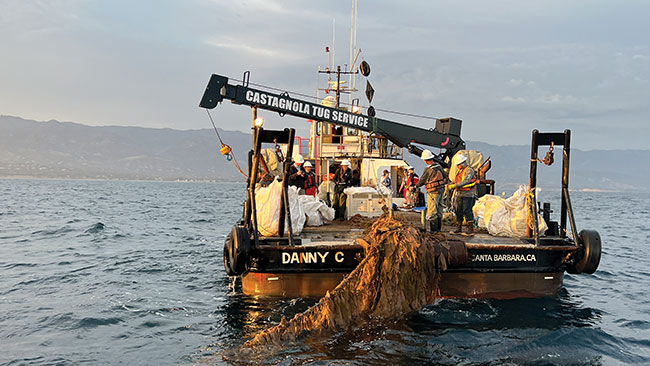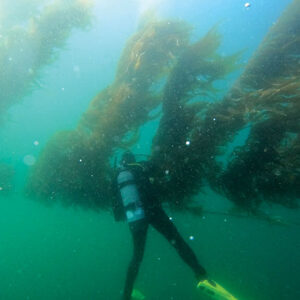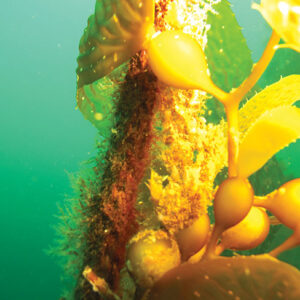
Growing pains for California kelp
February 12, 2024
By Julia Hollister
 Kelp harvesting vessel, pulling up grow lines of mature kelp for harvest (Photo: Ocean Rainforest Inc.)
Kelp harvesting vessel, pulling up grow lines of mature kelp for harvest (Photo: Ocean Rainforest Inc.) Kelp farming is gaining popularity in the State of California, but the permitting process remains water-logged.
Kelp aquaculture can contribute to climate change resilience and help mitigate the effects of climate change by reducing ocean acidification and carbon sequestration.
There are also economic gains from kelp and seaweed aquaculture, in terms of job creation, contributing to and reinvigorating our working waterfront and coastal communities, without the carbon footprint of imports.
A panel at the recent Seaweed Festival in San Diego, Calif. drew a large and interested crowd last November. In fact, according to panelists and organizers of the event, the seaweed farming panel tends to be one of the most popular panels at the festival.
The goal of the panel was to share with the audience the state of seaweed cultivation in California and information about the growing interest in seaweed farming.
“There are many different potential applications of cultivating seaweed, including for human consumption, medicines and cosmetics, feedstock for animals to reduce methane emissions, raw materials for bioplastics and other industrial applications, and as a biofuel source,” said Lauren Linsmayer, senior science officer at California Ocean Science Trust and panel facilitator at the Seaweed Festival.
“There’s a growing body of science showing that farming seaweed can be net beneficial to the environment and lead to restorative, regenerative, and conservation outcomes when done responsibly. We need to ensure that science is serving as a guidepost for the seaweed farming industry and that seaweed farming is being done responsibly within a science-informed state regulatory framework.”
About kelp
Seaweed is in the algae family, and kelp is essentially the largest subgroup of seaweed. Algae is a group of aquatic organisms that are mainly photosynthetic and nucleus-bearing.
In other words, they’re not your average plant: they lack stems, roots, and other common plant characteristics. The beauty of algae is that it absorbs the atmosphere’s carbon dioxide and produces approximately 50 percent of oxygen here on Earth.
Ocean farmers grow kelp vertically by wrapping tiny kelp plants grown on a string around a nautical rope, which hangs below the water’s surface from buoys.
California has a long history of cultivating seaweed on its shores. According to the California Sea Grant website, commercial seaweed cultivation first arrived in the Unites States around the 1960s.
In 1972, U.S. researchers explored the idea of growing kelp in hopes of converting the product to methane for fuel. Several experimental offshore kelp farms were launched during this time but it proved “economically uncompetitive” with fossil fuels and early efforts never grew to scale.
In 2019, the California Sea Grant reported the U.S. produced 3,394 tons of seaweed, just 0.01 percent of the global supply, most of which was wild harvested. By comparison, China leads the world, producing more than 20 million tones, nearly all farmed.
Barriers of entry
Randy Lovell, State Aquaculture Coordinator for the California Department of Fish & Wildlife, said there is a lot of interest in obtaining licenses for “few have the stamina to get through permitting as it currently is set up.”
“Yes, it is a challenge to establish a site in the public space that is the ocean off California. But that is not because of a specific law,” he explained. “It is because of the competition for coastal uses that avoid conflict with each other, and concerns about ANY type of development and its environmental impacts in the ocean (not specific just to aquaculture).”
California permitting is unique from other states as the California Environmental Quality Act (CEQA) requires extensive analysis and mitigation of environmental impacts and a robust public process. The CEQA process takes time and is expensive.
California does not generally have standard permit conditions or timelines for aquaculture projects due to varying regulatory authorities. Each project is individually considered which is time-intensive and requires significant agency staff resources to evaluate site-specific parameters (which vary throughout the state).
No new California Department of Fish and Wildlife (CDFW) aquaculture bottom leases have been approved in the past two decades.
Diane Windham is the West Coast regional aquaculture coordinator for the National Oceanic and Atmospheric Administration’s (NOAA) Fisheries division. She said the primary barriers to entry for offshore aquaculture, including kelp aquaculture is the time and cost of the regulatory permitting and environmental review process.
“In the U.S., we are on a learning curve to better understand the various types of aquaculture, and how to assess potential impacts from offshore aquaculture projects,” said Windham. “Because there are not very many permitted offshore aquaculture projects in the U.S. or in California, there is not a lot of baseline or foundational information to inform our analyses.”
Windham said the regulatory permitting agencies are learning how to adapt these processes to a different type of action. Permitting can take years to navigate and there is a cost associated with that – it makes it harder for smaller “mom and pop” type applicants to navigate the process.
As the process continues to evolve and more projects get permitted, Windham said this will create a baseline of information and experience that can inform future projects.
“Kelp farming laws that are developed in unison with the kelp farming industry could be helpful,” she said. “It is important to develop guidance/protocols based on the best available science and feasibility. Developing criteria, guidance, protocols, best practices, etc… have to be developed with industry to ensure that they are feasible and practicable.”
Room to grow
Kelp aquaculture can contribute to climate change resilience and help mitigate the effects of climate change by reducing ocean acidification and carbon sequestration. There are vast economic and health benefits to be realized through marine aquaculture, including kelp aquaculture.
Providing safe and healthy domestically produced seafood products contributes to food security. Locally produced aquaculture products, including kelp, increase the availability of food products, contributing to food security and reducing our dependence on imports.
There are economic gains from kelp and seaweed aquaculture (in addition to other forms of domestic aquaculture) in terms of job creation, contributing to and reinvigorating our working waterfront and coastal communities, without the carbon footprint of imports.
“Kelp is also an alternative ingredient in cattle feed, to reduce methane emissions from cattle, to offset ocean acidification for cosmetic products, for biofuel production, and the R&D and potential for using kelp for carbon sequestration in the ocean,” said Linsmayer.
A recent report by the Aquarium of the Pacific states that California continues to see a wide variety of marine aquaculture projects in the coming years in both state and federal waters.
Types of current and future projects include climate projects to grow seaweed to sequester carbon, produce methane-reducing additives to cattle feed, or provide a low-carbon additive to fuel. Others provide shoreline protection from erosion by dampening wave energy, etc.
Testing grounds
The Moss Landing Marine Lab, south of San Francisco, studies kelp. This is an ideal area. There are sand dunes, sandy beaches, and extensive kelp forest habitats along the rocky shoreline. Some of the most productive kelp forests and intertidal areas can be found in this region.
One operation that has secured permits to operate an experimental kelp farm in federal waters (off Santa Barbara) is Ocean Rainforest Inc.
“Ocean Rainforest began in 2010, when we combined our knowledge of this unique ocean environment with our strong entrepreneurial spirit, to cultivate seaweed,” said Eliza Harrison, Ocean Rainforest director of California operations.
“We started growing and harvesting the same species of wild seaweeds that formed part of our ancestors’ diets over a thousand years ago, because we wanted to have a positive impact on people and the environment.”
Harrison said the company has an inbuilt focus on research and innovation to explore the potential of this versatile sea plant and meet growing market demand.
Correction: The original article published in the January/February 2024 issue implied that Ocean RainForest Inc. is working with AltaSeeds Conservancy on kelp genetic diversity. Ocean RainForest Inc. is not affiliated with AltaSeeds Conservancy. Aquaculture North America regrets its error.
Advertisement
- First Nations group launches billboard campaign to promote B.C. farmed salmon
- Appalachian Salmon closes second seed fund for RAS facility







